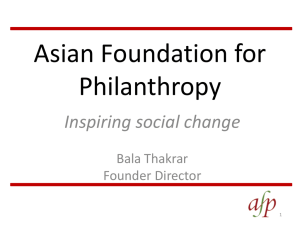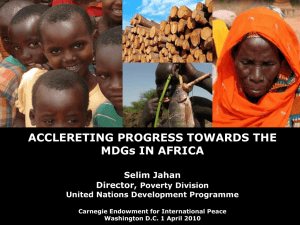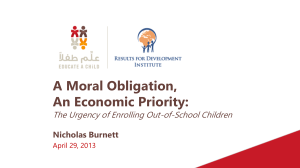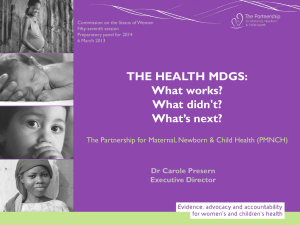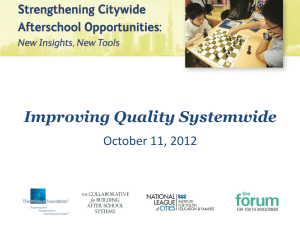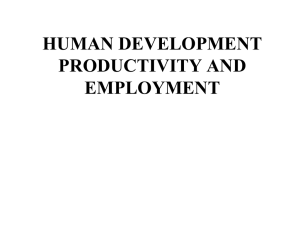presentation (PPT)
advertisement
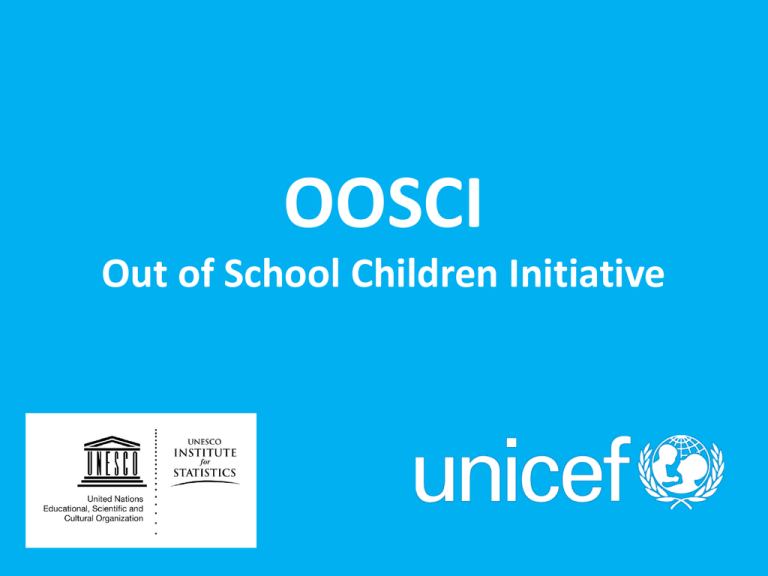
OOSCI Out of School Children Initiative What is the Out of School Children Initiative? OOSCI was launched in 2010 by UNICEF and UIS Who are the children out of school and where are they? Why are these children out of school? How can they be brought to school and stay there? Why do we want ALL children in school? Education is a human right. It empowers people to survive and thrive and is our most effective weapon against poverty Education is associated with more peaceful communities, greater civic engagement and stronger democracies Half of the recent reduction in maternal and infant mortality is due to more education for girls Education is one of the best economic investments available with returns of $10 - $15 on the dollar Each addition year of schooling is associated with an increase of 0.37% in GDP, rising to 1.0% with improved learning outcomes As many as 250 million children of primary school age are failing to learn the basics What does OOSCI do? OOSCI aims to make a substantial and sustainable reduction in the number of children out of school How much progress has been made? • 30+ Country Studies completed • 20+ Country Studies in the pipeline • 7 Regional Reports published • Global Report launched on 19 January 2015 Out-of-school children: What data (visually) tells Hiro Hattori Data & Analytics Section UNICEF, New York If the world were a village of 100 children of primary school age… 9% of children out of school II 58 million If the world were a village of 100 adolescents of lower secondary school age… 17% of adolescents out of school II 63 million Reasons for out-of-school vary among regions. The global trend of OOSC The global trend of OOSC Need another 200 years! 2013 2014 2015 2016 2017 2018 Progress of MDG Indicators, Relative Change 1990-2012 110 100 MDG 2 Out-of-school Rate Value relative to 1990 (1990 = 100) 90 80 70 MDG 1 Poverty Rate MDG 4 U5MR MDG 1 Stunting 60 50 40 30 1990 1991 1992 1993 1994 1995 1996 1997 1998 1999 2000 2001 2002 2003 2004 2005 2006 2007 2008 2009 2010 2011 2012 Progress of MDG Indicators, Relative Change 1990-2012 110 100 MDG 2 Out-of-school Rate Value relative to 1990 (1990 = 100) 90 80 70 MDG 1 Poverty Rate MDG 4 U5MR MDG 1 Stunting 60 50 40 30 1990 1991 1992 1993 1994 1995 1996 1997 1998 1999 2000 2001 2002 2003 2004 2005 2006 2007 2008 2009 2010 2011 2012 Stagnation of education MDG alarming! Number of out-of-school children by region, 2000-2012 50000000 45000000 40000000 Sub-Saharan Africa 35000000 30000000 25000000 Southern Asia 20000000 15000000 East Asia and the Pacific 10000000 Latin America & the Caribbean 5000000 Central and Eastern Europe 0 2000 2001 2002 2003 2004 2005 2006 2007 2008 2009 2010 2011 2012 SSA and SA are main drivers of stagnation. Why has the progress stalled in recent years? GDP growth (annual %), 2000-2013 12 Sub-Saharan Africa 10 South Asia 8 % 6 4 2 World 0 2000 2001 2002 2003 2004 2005 2006 2007 2008 2009 2010 2011 2012 2013 -2 -4 Economic growth has slowed down since 2008. Increased cases of emergencies and humanitarian crisis. Majority of countries with high OOS rate are conflict-affected. Number of out-of-school children of primary school age, 2002-2012 70,000,000 60,000,000 Conflict-affected countries 50,000,000 40,000,000 30,000,000 Non conflict-affected countries 20,000,000 10,000,000 2002 2003 2004 2005 2006 2007 2008 2009 2010 2011 2012 Existing data do not support conflict hypothesis. Change in number of out-of-school children between 2007 and 2012 -1,500,000 -1,000,000 -500,000 0 500,000 1,000,000 1,500,000 Pakistan Mexico Morocco Ghana Niger Algeria Russian Federation Ukraine Burkina Faso Lao PDR Eritrea Turkey Colombia South Africa United States of America Indonesia Nigeria Performance of big countries affect global trends. Primary school age population, index of change, 2000-2012 140 130 Sub-Saharan Africa Value relative to 2000 (2000 = 100) 120 110 Latin America & the Caribbean Southern Asia 100 World 90 80 East Asia and the Pacific 70 60 2000 2001 2002 2003 2004 2005 2006 2007 2008 2009 2010 2011 2012 Rapid population growth in sub-Saharan Africa Primary school age population and enrolment, Sub-Saharan Africa, 2000-2012 150,000,000 140,000,000 Primary school age population 130,000,000 120,000,000 110,000,000 100,000,000 Primary school enrolment 90,000,000 80,000,000 70,000,000 60,000,000 2000 2001 2002 2003 2004 2005 2006 2007 2008 2009 2010 2011 2012 Faster growth in school enrolment needed. Primary school age population and enrolment, Southern Asia, 2000-2012 180,000,000 Primary school age population 170,000,000 160,000,000 150,000,000 Primary school enrolment 140,000,000 130,000,000 120,000,000 110,000,000 100,000,000 2000 2001 2002 2003 2004 2005 2006 2007 2008 2009 2010 2011 2012 School enrolment has stagnated since 2007. “Business as usual” wouldn’t work to reach the hardest to reach. “Build it, they will come” optimism won’t work any more. Where are the world’s 58 million out of school children? All countries Sudan Afghanistan Nigeria Pakistan Democratic Republic of the Congo OOSC > 0.5 million Philippines Ethiopia United States Indonesia India OOSC > 0.5 million Somalia Eritrea South Sudan Liberia Sudan Afghanistan Djibouti Nigeria Equatorial Guinea Guyana Democratic Republic of the Congo Pakistan OOSC rate > 20% OOSC rate > 20% High proportions and numbers of OOSC concentrate in Horn of Africa and Western and Central Africa. OOSC rate > 20% Which children are out of school? Headlines 50% of out-of-school children live in countries affected by conflict 50% of out-of-school children live in sub-Saharan Africa 53% of out-of-school children are girls Amongst out-of-school children 43% will never enter school 34% will enter school late 23% will drop out early Who are these children? More likely to be out of school: • Children from the poorest families • Children affected by conflict or natural disasters • Girls • Children with disabilities • Children from rural areas • Working children • Children from minority ethnic or language groups Why are they out of school? Most common barriers: • Cost of going to school • Gender bias in culture or school system • No schools nearby • Schools don’t accept children with disabilities • Security • No jobs after finishing school • Language of instruction What policies can get children into school? Profile Barrier Policy options Girls from poor rural areas Cultural practices Campaigns or legislation Distance Satellite schools Cost Abolish all fees Infrastructure New funding formula Children with disabilities Cultural bias Campaigns Accessibility Building regulations Children > 1 yr over age Late entry Increase ECD Repetition Automatic promotion Why is equity important? Thank you


